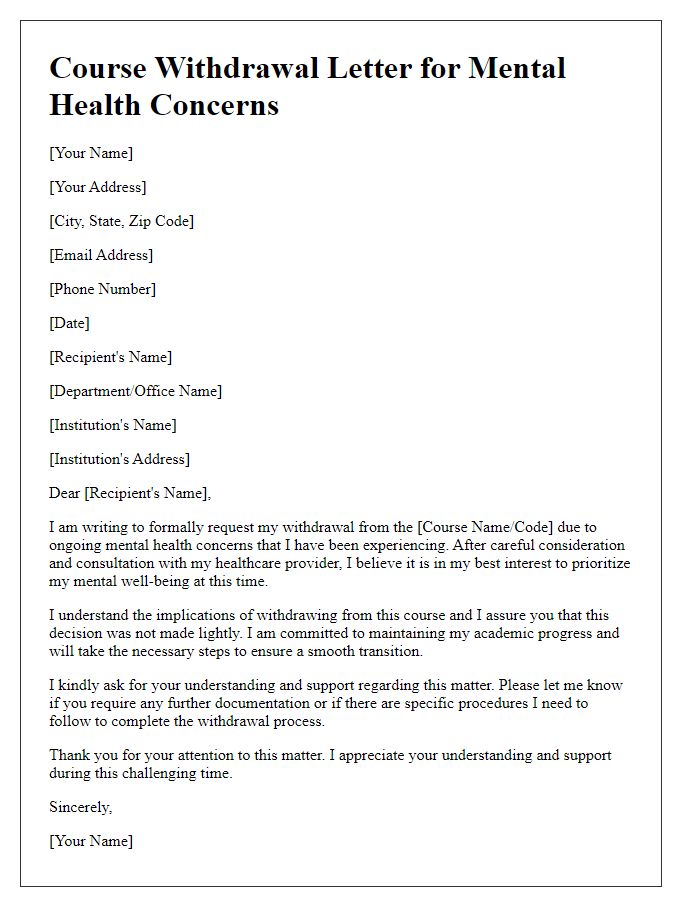Are you considering withdrawing from a course and feeling unsure about how to communicate your decision? Writing a withdrawal letter can seem daunting, but it doesn't have to be! It's important to be clear and concise as you explain your reasons while also maintaining a respectful tone. If you're looking for guidance on crafting the perfect course withdrawal approval letter, keep reading for helpful tips and a simple template!

Student's Full Name and ID
Withdrawing from a course may significantly impact a student's academic trajectory, specifically for students enrolled in universities like Harvard or Stanford. A formal withdrawal request typically requires the student's full name, such as "Johnathan Michael Smith," and a unique identification number, often consisting of eight digits, like "12345678." This procedure ensures proper documentation and processing by the academic registrar. Additionally, students may need to provide reasons for withdrawal, such as health issues or personal challenges, which could influence their ability to continue coursework. Adhering to deadlines is crucial, as many institutions impose strict timelines for withdrawal requests--usually within the first two-thirds of the semester.
Course Details (Name & Code)
Course withdrawal often necessitates formal approval from academic authorities. A detailed request includes the course's name, such as "Introduction to Psychology" with the code "PSY101." This information helps identify the specific course for which withdrawal is being sought, linking it to the academic semester and institutional guidelines. Additionally, outlining reasons for withdrawal, such as personal circumstances or academic challenges, can support the request's validity. The inclusion of a date, typically within the withdrawal timeline specified by the institution, is crucial for ensuring compliance with academic policies. This process often involves notifying the registrar's office, which handles enrollment adjustments.
Reason for Withdrawal
A course withdrawal can significantly impact academic progress and personal circumstances. Common reasons for withdrawal include health issues, family emergencies, workload conflicts, or lack of engagement with course material. For instance, a student may face significant health challenges, such as a diagnosed medical condition requiring treatment, or personal obligations like caring for a family member facing a crisis. High levels of stress due to an increased course load, particularly during finals week (which typically occurs in May for many institutions), can also prompt a reevaluation of academic commitments. Another possibility involves finding a course not aligning with a student's major or career goals, leading to dissatisfaction and the need for a course change. Each of these factors can impede a student's ability to succeed in the course, necessitating formal withdrawal requests to ensure that academic records accurately reflect their performance and challenges faced during the semester.
Deadline Compliance
Students wishing to withdraw from courses at universities like Harvard or Stanford must submit a withdrawal request by specific deadlines, typically 4 weeks into the semester. Compliance with these deadlines is crucial to avoid financial penalties and maintain academic standing (such as GPA impacts). Submission usually requires forms indicating course details (course code, title), student identification, and a rationale for withdrawal. Departments may also require approval signatures from academic advisors to ensure understanding of implications on degree progression and financial aid eligibility. Failing to adhere to these protocols may result in receiving a failing grade (WF) on transcripts instead of a withdrawal (W).
Contact Information for Follow-up
Course withdrawal requests must include detailed contact information for prompt follow-up. Students should provide their full name, current university ID number, and an active email address (such as Gmail or university-provided email). A phone number, preferably a mobile number (including the area code), ensures that administrative staff can reach out for any clarifications. Additionally, including a mailing address may facilitate formal correspondence regarding the withdrawal status, especially if documentation needs to be sent. Clear identification aids in quickly processing the request and maintaining accurate communication records.
Letter Template For Course Withdrawal Approval Samples
Letter template of course withdrawal justification for change in career path

Letter template of course withdrawal notification for financial challenges












Comments